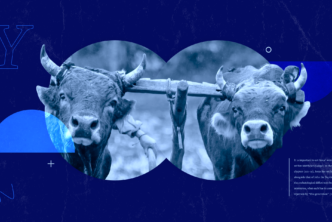I make known the end from the beginning, from ancient times, what is still to come.
— Isaiah 46:10, NIV
The significance of Palm Sunday was lost on me as a child. I suspect it’s lost on most Christian adults, too.
My first memories of Palm Sunday were of sitting patiently in Sunday school next to my friends, holding palm fronds. When signaled, we waved them high while singing “Hosanna! Hosanna in the highest!” to a slightly off-key piano. I understood enough about Palm Sunday as a child to know it was the day Jesus rode into Jerusalem on a donkey and was hailed King of the Jews. But it wasn’t until a few years ago I began to comprehend the significance of what happened on that date and why it’s so profound for followers of Jesus. (Notice I wrote “date,” not “day.”)
Let’s start in the book of John, the week before Jesus was crucified.
Six days before Passover
Six days before the Passover, Jesus therefore came to Bethany, where Lazarus was, whom Jesus had raised from the dead. So they gave a dinner for him there. Martha served, and Lazarus was one of those reclining with him at table. … When the large crowd of the Jews learned that Jesus was there, they came, not only on account of him but also to see Lazarus, whom he had raised from the dead. … The next day the large crowd that had come to the feast heard that Jesus was coming to Jerusalem. (John 12:1–2, 9, 12; emphasis added)
John 12:1–2 says that six days before Passover Jesus went to Bethany, a small village a few miles outside of Jerusalem just beyond the Mount of Olives. There he shared a meal with Mary, Martha, and Lazarus. Word had spread that Jesus had recently raised Lazarus from the dead, and curious crowds had begun to gather (9, 12). But it’s the first three words of verse 12 that I want to focus on: “The next day.”
The next day the large crowd that had come to the feast heard that Jesus was coming to Jerusalem. (John 12:12, emphasis added)
What is so important about these three words?
To better understand their significance, journey back with me 3,500 years to the time of the Exodus.
A lamb, without blemish
At the tail end of Israel’s 400 years of slavery in Egypt, God gave the nation some specific instructions:
Tell the whole community of Israel that on the tenth day of this month each man is to take a lamb for his family, one for each household. … Your lamb shall be without blemish, a male a year old. … Take care of them until the fourteenth day of the month, when all the members of the community of Israel must slaughter them at twilight. (Exod 12:3 and 6, emphasis added)
On “the tenth day of this month” (Nisan 10, the first month of the Israelite calendar),1 each family was to choose a one-year-old lamb “without blemish” (no defect),2 bring it into their home, and care for it for five days. On Nisan 14,3 they were to slaughter it just before sundown and put its blood on the lintel and doorposts of their home (Exod 12:21–23; see also Lev 23:5; Num 9:2–5, 28:16; Josh 5:10–11).
It was an act of obedience and trust.
That same night, the Lord would “pass over” every home he saw with the lamb’s blood:
On that same night I will pass through Egypt and strike down every firstborn—both men and animals—and I will bring judgment on all the gods of Egypt. I am the LORD. (Exod 12:12; see also Exod 12:42)
Because a new Hebrew day begins at twilight 4 “that same night” would have been Nisan 15.5 It was on this date Israel left Egypt and passed through the Red Sea—the date God redeemed the Israelites out of slavery.
Passover has been Judaism’s transformative event ever since. It’s celebrated every year on Nisan 15—falling in March or April on our Gregorian calendars.
Now, let’s circle back to the scene in John 12 and connect some dots.
Gentle, riding, and on a donkey
Six days before Passover puts Jesus in Bethany on Nisan 9 (Nisan 15 minus 6 days).6 “The next day” would have been Nisan 10—the same “date” the Israelites were to bring “lambs without blemish” into their homes.
Almost 1,500 years after the first Passover in Egypt, Jesus entered Jerusalem on a donkey, on Nisan 10.
The crowds who were in Jerusalem to celebrate Passover met him with palm branches shouting: “Hosanna! (Save now!) Blessed is he who comes in the name of the Lord, even the King of Israel!” (John 12:13; from Psalm 118:19–27). Matthew 21:8 adds more information:
Most of the crowd spread their cloaks on the road, and others cut branches from the trees and spread them on the road. (Matt 21:8, see also Mark 11:7–8.)
This act was reserved for kings and conquerors (2 Kings 9:13).7
The people missed the full significance of the circumstances. Two things were happening, but they only saw one: Jesus fulfilling Zechariah’s prophecy.
Your king comes to you, gentle and riding on a donkey. (Zech 9:9)
It was a prophecy the Jews knew well. When Jesus passed through Jerusalem’s gates, they were openly proclaiming him as their Savior and King (though in the sense of relieving Israel from Roman oppression).
What they didn’t see was God’s selection of Jesus Christ as the final Passover lamb to be slaughtered.
The stage was set for the events of the final week of his life, leading to his suffering, crucifixion, death, and resurrection. Just a few days later on Nisan 14, as upwards of 250,000 lambs8 were being sacrificed in the temple courts according to God’s instruction in Exodus 12, Jesus would be nailed to a cross.9
So what does Palm Sunday celebrate?
We remember and celebrate Palm Sunday as both the triumphal entry and the day “Christ our Passover” was set apart as “a lamb without blemish or defect” (1 Pet 1:19 NIV) to be sacrificed for our sins (1 Cor 5:7; see also Luke 23:4–22).
It’s why John the Baptist declared just before baptizing Jesus:
Behold, the Lamb of God who takes away the sin of the world! (John 1:29)
The book of Hebrews says the Old Testament sacrificial system is only a shadow of the good things to come—not the realities themselves (Heb 10:1, see also Col 2:16–17). Exodus 12:3 was the shadow, the picture of what would happen centuries later when Jesus of Nazareth entered Jerusalem.10 Just as Isaiah declared, God made known the end from the beginning (46:10).
And we get to marvel at the perfection of God’s timing—and his Word—through three short words in John:
The next day.
***
Related posts
- The Triumphal Entry: The Pathway to Glory
- Did Jesus Go to Hell after He Died?
- Is Easter a Pagan Holiday? Some Say Yes—but Is It Really?
- Is the Word ‘Easter’ in the Bible?
Related resources
- What Was Jesus’ Tomb Really Like? Explore a First-Century Tomb (Interactive)
- Mobile Ed: Jesus and the Resurrection Bundle (3 courses)
- Raised on the Third Day: Defending the Historicity of the Resurrection of Jesus by David Beck
- Are You the One Who Is to Come? The Historical Jesus and the Messianic Question by Michael Bird
- The Final Days of Jesus: The Most Important Week of the Most Important Person Who Ever Lived by Andreas J. Köstenberger
- NISAN (נִיסָן, Nisan). The first month of the Israelite calendar, corresponding approximately to March/April. Barry, John. Lexham Bible Dictionary, “Nisan,” (Lexham Press, Bellingham WA), 2016.
- Defects of conduct are also metaphorically called blemishes (Deut 32:5; Prov 9:7; Job 11:15); https://www.jewishvirtuallibrary.org/blemish
- As to the Passover of Egypt [the lamb’s] designation took place on the tenth of Nisan. Neusner, Jacob. A History of the Mishnaic Law of Appointed Times, Part Two: Erubin, “Pesahim: Translation and Explanation,” 9:5b, (Wipf & Stock), 2007.
- https://www.chabad.org/library/article_cdo/aid/526873/jewish/The-Jewish Day.htm
- Neusner, Jacob. A History of the Mishnaic Law of Appointed Times, Part Two: Erubin, “Pesahim: Translation and Explanation,” 9:5b, (Wipf & Stock), 2007.
- There is disagreement among scholars as to the exact “date” Jesus entered Jerusalem, and this gap is largely because of a misunderstanding of the Hebrew calendar, how it functions and the start/stop of Hebrew days. Regardless, the perfection of God’s timing in John 12 and the events that happened that week compared to Exodus 12 is something to consider.
- Palm branches were used on occasions of festivity (Lev 23:40, Neh 8:15). They were regarded as tokens of joy and triumph. Kings and conquerors were welcomed by having palm branches strewn before them and waved in the air. Thus they were waved before the Messiah on the occasion of his entry into Jerusalem (John 12:13). Freeman, James M., The New Manners and Customs of the Bible (Bridge-Logos), 1998.
- Jewish Wars 6.93, Josephus
- Neusner, Jacob. A History of the Mishnaic Law of Appointed Times, Part Two: Erubin, “Pesahim: Translation and Explanation,” 9:5b, (Wipf & Stock), 2007.
- Passover is one of the seven “feasts” (festivals, or “appointed times”) listed in Leviticus 23 and part of the Old Testament sacrificial law.







